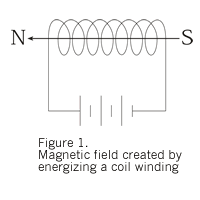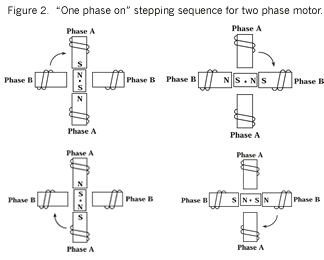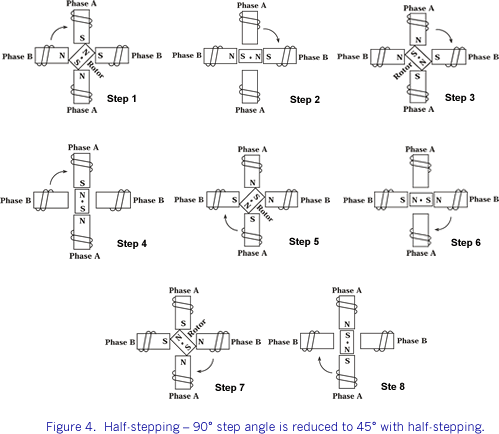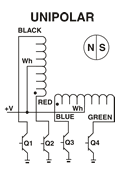Stepper Motor Theory
Download PDF full discription:
 Step Motor Theory
Step Motor Theory
 Motors convert electrical energy into mechanical energy. A stepper motor converts electrical pulses into specific rotational movements. The movement created by each pulse is precise and repeatable, which is why stepper motors are so effective for positioning applications.
Motors convert electrical energy into mechanical energy. A stepper motor converts electrical pulses into specific rotational movements. The movement created by each pulse is precise and repeatable, which is why stepper motors are so effective for positioning applications.
Permanent Magnet stepper motors incorporate a permanent magnet rotor, coil windings and magnetically conductive stators. Energizing a coil winding creates an electromagnetic field with a north and south pole as shown in figure 1. The stator carries the magnetic field which causes the rotor to align itself with the magnetic field. The magnetic field can be altered by sequentially energizing or "stepping" the stator coils which generates rotary motion.
 One phase on stepping sequence Figure 2 illustrates a typical step sequence for a two phase motor. In Step 1 phase A of a two phase stator is energized. This magnetically locks the rotor in the position shown, since unlike poles attract. When phase A is turned off and phase B is turned on, the rotor rotates 90° clockwise. In Step 3, phase B is turned off and phase A is turned on but with the polarity reversed from Step 1. This causes another 90° rotation. In Step 4, phase A is turned off and phase B is turned on, with polarity reversed from Step 2. Repeating this sequence causes the rotor to rotate clockwise in 90° steps.
One phase on stepping sequence Figure 2 illustrates a typical step sequence for a two phase motor. In Step 1 phase A of a two phase stator is energized. This magnetically locks the rotor in the position shown, since unlike poles attract. When phase A is turned off and phase B is turned on, the rotor rotates 90° clockwise. In Step 3, phase B is turned off and phase A is turned on but with the polarity reversed from Step 1. This causes another 90° rotation. In Step 4, phase A is turned off and phase B is turned on, with polarity reversed from Step 2. Repeating this sequence causes the rotor to rotate clockwise in 90° steps.
The stepping sequence illustrated in figure 2 is called "one phase on" stepping. A more common method of stepping is "two phase on" where both phases of the motor are always Two phase on stepping sequenceenergized.  However, only the polarity of one phase is switched at a time, as shown in figure 3. With two phase on stepping the rotor aligns itself between the "average" north and "average" south magnetic poles. Since both phases are always on, this method gives 41.4% more torque than "one phase on" stepping, but with twice the power imput.
However, only the polarity of one phase is switched at a time, as shown in figure 3. With two phase on stepping the rotor aligns itself between the "average" north and "average" south magnetic poles. Since both phases are always on, this method gives 41.4% more torque than "one phase on" stepping, but with twice the power imput.
Half Stepping
The motor can also be "half stepped" by inserting an off state between transitioning phases. This cuts a stepper's full step angle in half. For example, a 90° stepping motor would move 45° on each half step, figure 4. However, half stepping typically results in a 15% - 30% loss of torque depending on step rate when compared to the two phase on stepping sequence. Since one of the windings is not energized during each alternating half step there is less electromagnetic force exerted on the rotor resulting in a net loss of torque. 
Unipolar Stepping
The two phase stepping sequence described utilizes a "bipolar coil winding." Each phase consists of a single winding. By reversing the current in the windings, electromagnetic polarity is reversed. The output stage of a typical two phase bipolar drive is further illustrated in the electrical schematic diagram and stepping sequence in figure 5. As illustrated, switching simply reverses the current flow through the winding thereby changing the polarity of that phase.






